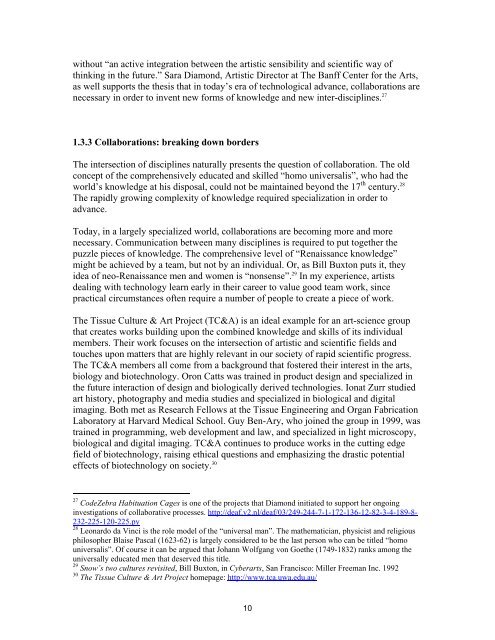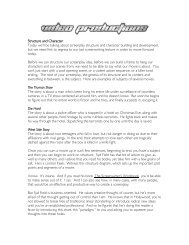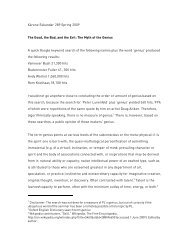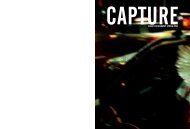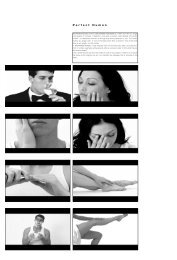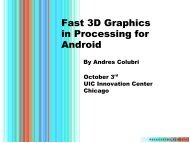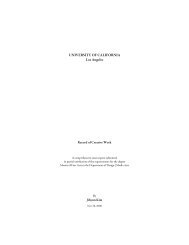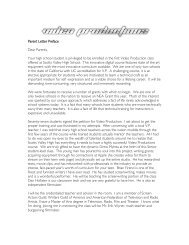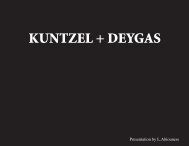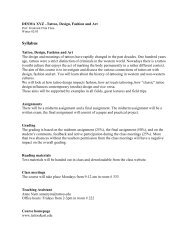Singing cells, art, science and the noise in between - Users - UCLA
Singing cells, art, science and the noise in between - Users - UCLA
Singing cells, art, science and the noise in between - Users - UCLA
You also want an ePaper? Increase the reach of your titles
YUMPU automatically turns print PDFs into web optimized ePapers that Google loves.
without “an active <strong>in</strong>tegration <strong>between</strong> <strong>the</strong> <strong>art</strong>istic sensibility <strong>and</strong> scientific way of<br />
th<strong>in</strong>k<strong>in</strong>g <strong>in</strong> <strong>the</strong> future.” Sara Diamond, Artistic Director at The Banff Center for <strong>the</strong> Arts,<br />
as well supports <strong>the</strong> <strong>the</strong>sis that <strong>in</strong> today’s era of technological advance, collaborations are<br />
necessary <strong>in</strong> order to <strong>in</strong>vent new forms of knowledge <strong>and</strong> new <strong>in</strong>ter-discipl<strong>in</strong>es. 27<br />
1.3.3 Collaborations: break<strong>in</strong>g down borders<br />
The <strong>in</strong>tersection of discipl<strong>in</strong>es naturally presents <strong>the</strong> question of collaboration. The old<br />
concept of <strong>the</strong> comprehensively educated <strong>and</strong> skilled “homo universalis”, who had <strong>the</strong><br />
world’s knowledge at his disposal, could not be ma<strong>in</strong>ta<strong>in</strong>ed beyond <strong>the</strong> 17 th century. 28<br />
The rapidly grow<strong>in</strong>g complexity of knowledge required specialization <strong>in</strong> order to<br />
advance.<br />
Today, <strong>in</strong> a largely specialized world, collaborations are becom<strong>in</strong>g more <strong>and</strong> more<br />
necessary. Communication <strong>between</strong> many discipl<strong>in</strong>es is required to put toge<strong>the</strong>r <strong>the</strong><br />
puzzle pieces of knowledge. The comprehensive level of “Renaissance knowledge”<br />
might be achieved by a team, but not by an <strong>in</strong>dividual. Or, as Bill Buxton puts it, <strong>the</strong>y<br />
idea of neo-Renaissance men <strong>and</strong> women is “nonsense”. 29 In my experience, <strong>art</strong>ists<br />
deal<strong>in</strong>g with technology learn early <strong>in</strong> <strong>the</strong>ir career to value good team work, s<strong>in</strong>ce<br />
practical circumstances often require a number of people to create a piece of work.<br />
The Tissue Culture & Art Project (TC&A) is an ideal example for an <strong>art</strong>-<strong>science</strong> group<br />
that creates works build<strong>in</strong>g upon <strong>the</strong> comb<strong>in</strong>ed knowledge <strong>and</strong> skills of its <strong>in</strong>dividual<br />
members. Their work focuses on <strong>the</strong> <strong>in</strong>tersection of <strong>art</strong>istic <strong>and</strong> scientific fields <strong>and</strong><br />
touches upon matters that are highly relevant <strong>in</strong> our society of rapid scientific progress.<br />
The TC&A members all come from a background that fostered <strong>the</strong>ir <strong>in</strong>terest <strong>in</strong> <strong>the</strong> <strong>art</strong>s,<br />
biology <strong>and</strong> biotechnology. Oron Catts was tra<strong>in</strong>ed <strong>in</strong> product design <strong>and</strong> specialized <strong>in</strong><br />
<strong>the</strong> future <strong>in</strong>teraction of design <strong>and</strong> biologically derived technologies. Ionat Zurr studied<br />
<strong>art</strong> history, photography <strong>and</strong> media studies <strong>and</strong> specialized <strong>in</strong> biological <strong>and</strong> digital<br />
imag<strong>in</strong>g. Both met as Research Fellows at <strong>the</strong> Tissue Eng<strong>in</strong>eer<strong>in</strong>g <strong>and</strong> Organ Fabrication<br />
Laboratory at Harvard Medical School. Guy Ben-Ary, who jo<strong>in</strong>ed <strong>the</strong> group <strong>in</strong> 1999, was<br />
tra<strong>in</strong>ed <strong>in</strong> programm<strong>in</strong>g, web development <strong>and</strong> law, <strong>and</strong> specialized <strong>in</strong> light microscopy,<br />
biological <strong>and</strong> digital imag<strong>in</strong>g. TC&A cont<strong>in</strong>ues to produce works <strong>in</strong> <strong>the</strong> cutt<strong>in</strong>g edge<br />
field of biotechnology, rais<strong>in</strong>g ethical questions <strong>and</strong> emphasiz<strong>in</strong>g <strong>the</strong> drastic potential<br />
effects of biotechnology on society. 30<br />
27 CodeZebra Habituation Cages is one of <strong>the</strong> projects that Diamond <strong>in</strong>itiated to support her ongo<strong>in</strong>g<br />
<strong>in</strong>vestigations of collaborative processes. http://deaf.v2.nl/deaf/03/249-244-7-1-172-136-12-82-3-4-189-8-<br />
232-225-120-225.py<br />
28 Leonardo da V<strong>in</strong>ci is <strong>the</strong> role model of <strong>the</strong> “universal man”. The ma<strong>the</strong>matician, physicist <strong>and</strong> religious<br />
philosopher Blaise Pascal (1623-62) is largely considered to be <strong>the</strong> last person who can be titled “homo<br />
universalis”. Of course it can be argued that Johann Wolfgang von Goe<strong>the</strong> (1749-1832) ranks among <strong>the</strong><br />
universally educated men that deserved this title.<br />
29 Snow’s two cultures revisited, Bill Buxton, <strong>in</strong> Cyber<strong>art</strong>s, San Francisco: Miller Freeman Inc. 1992<br />
30 The Tissue Culture & Art Project homepage: http://www.tca.uwa.edu.au/<br />
10


